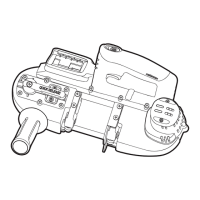11
ASSEMBLY INSTRUCTIONS
BLADES
This cordless band saw is to be used only with 0.02" (0.5 mm) thick, 1/2" (12.5 mm) wide and
28 13/16" (732 mm) long blades.
BLADES SELECTION
In general, consider the size and shape of the work and the type of material to be cut. The coarser
the tooth on the blade, the faster the cut will be. In selecting the appropriate number of teeth per inch
of the band saw blade, at least two teeth should contact the work surface when the blade is rested
against the workpiece. As a rule of thumb, soft materials usually require coarse tooth blades, while
hard materials require fine tooth blades. Where a smoother finish is important, select one of the finer
tooth blades.
Select the appropriate band saw blade according to the material type, dimensions, and number of
teeth. See Blade Description chart.
The following table is intended as a general guide only. Determine the type of material and dimension
of the workpiece and select the most appropriate band saw blade.
Blade Decsription:
Teeth per inch Work condition
10 For tough stock 3/16" (4.8 mm) up to 2 1/2" (6.4 cm) in diameter or width.
14 For tough stock 5/32" (4 mm) up to 3/4" (19 mm) in diameter or width.
18 For thin-wall tubing and thin sheets heavier than 21 gauge.
24 For thin-wall tubing and thin sheets heavier than 21 gauge.
ASSEMBLY INSTRUCTIONS
NOTICE:
• The use of any other blade or accessory might be hazardous. DO NOT use any other type of accessory with your band saw.
Blades used on stationary band saws are of different thickness. Do not attempt to use them on your portable unit.
• Never use the band saw to cut resin materials, which are subject to melting. Melting of resin material caused by high heat
generated during cutting may cause the band saw blade to become bound to the material, possibly resulting in overload and
burn-out of the motor.

